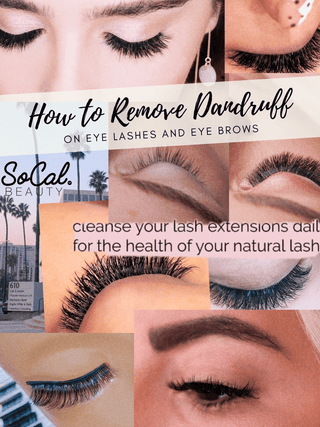How to remove Dandruff on Eye Lashes and Eye Brows
Dandruff isn’t uncommon and is often easily fixed with an over-the-counter medicated shampoo. However, when you start seeing dandruff accumulate on your eyelashes and eyebrows, you might be wondering what you should do and why it’s even there in the first place.
What causes dandruff on lashes and brows?
When it comes to your eyelashes, there are several conditions that may be responsible for this. Commonly, an eye condition called blepharitis is the culprit. It causes soreness and itchiness that can cause the delicate skin on your eyelids to dry out. This is what leads to those unsightly dandruff flakes.
Often, it’s a condition called seborrheic dermatitis that causes dandruff to build up on your brows due to the irritation, inflammation, and excess oil production that it causes. While this isn’t harmful to you, it’s unlikely to be the look you were hoping for and is something you’re going to want to take care of pretty quickly.
There are other causes of dandruff on the lashes and brows, but most will respond to the same type of care. One thing you should always avoid doing is scratching at the area as this will likely worsen the condition and increase your chance of getting an infection or spreading an infection from one eye to another.
Wash your face twice daily to help reduce flakes
Keeping the area clean is definitely one way to start tackling the issue, and depending on just how bad the problem is for you, it's something that you could try doing up to four times a day if convenient. Special shampoos for your lashes that contain tea tree can be helpful in combating those pesky flakes and will help reduce the flakes on brows, too.

When you wash, try to massage the lash line and brow area with your finger to help soften and remove flakes as you clean. You’re also going to want to pay closer attention to the lash line than you normally would as the base of your lashes is where dandruff buildup will accumulate most. Try to gently tug your eyelid out away from the eye a little for protection and then use a washcloth to rub the lash line very carefully. Make sure you have two washcloths that you can tell apart as you should be using a separate one for each eye whenever there is any question of infection.
You could also try taking a very warm washcloth and applying it to the area for a few minutes to help soften and loosen flakes. It is also likely to provide relief if the condition has been causing any discomfort or swelling to the eye area.
Give a little helping hand to your cleansing routine
When you’ve suffered from any kind of skin complaint, your skin will have gone through a pretty tough time. It can be helpful to pay extra attention to cleansing the lash line and helping to rejuvenate it. This Squeaky | Rose Water Cleanser can be used between washing the face and is formulated with rose water and hyaluronic acid. Whatever products you decide to go with, try to choose one containing rose water as it has natural antiseptic, anti-bacterial and anti-inflammatory properties that can help with the symptoms of eye conditions that cause dandruff.

Many products pack in extra ingredients such as hyaluronic acid to fight signs of aging such as lines and wrinkles. Hyaluronic acid works by delivering intense moisture to the skin for a longer amount of time and can help skin recover from the trauma of a skin condition that can leave it looking older than it really is.
Keep an eye on the condition over time
It’s important to realize that, although usually harmless, an eye or skin condition that doesn’t go away after treatment should always be checked by your doctor for their expert opinion and treatment. There can be the rare occasion when you might need specific treatment, and just trying to cleanse away the problem for the long term could prevent you from getting the help you need.

With a little care, you can feel more confident again
As we've explained, there are several things you can do to reduce your eyebrow and eyelash dandruff and help you look and feel more confident. Cleansing and moisturizing the area several times a day, using products that are designed for the job, and seeking expert help if the condition doesn’t clear up are the best things you can do.

